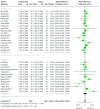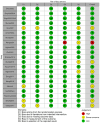A Comparison of Norepinephrine versus Phenylephrine to Prevent Hypotension after Spinal Anesthesia for Cesarean Section: Systematic Review and Meta-Analysis
- PMID: 39201995
- PMCID: PMC11355940
- DOI: 10.3390/jpm14080803
A Comparison of Norepinephrine versus Phenylephrine to Prevent Hypotension after Spinal Anesthesia for Cesarean Section: Systematic Review and Meta-Analysis
Abstract
Background: This systematic review and meta-analysis aimed to compare the effects of using phenylephrine or norepinephrine on the pH and base excess (BE) of the umbilical artery and vein in parturients undergoing cesarean section.
Methods: The study protocol was registered in INPLASY. Independent researchers searched Ovid-Medline, Ovid-EMBASE, and Cochrane Central Register of Controlled Trials (CENTRAL) databases and Google Scholar for relevant randomized controlled trials (RCTs). The primary outcome of this study was the umbilical artery (UA) or umbilical vein (UV) pH as neonatal condition at birth, and the secondary outcome was the UA or UV BE as an additional prognostic value over the measurement of umbilical pH.
Results: There was no evidence of a difference between phenylephrine and norepinephrine for overall, UA, and UV pH (mean difference (MD) -0.001, 95% confidence interval (CI) -0.004 to 0.007; MD 0.000, 95%CI -0.004 to 0.004; and MD 0.002, 95%CI -0.013 to 0.017). There was also no evidence of a difference between phenylephrine and norepinephrine for overall, UA, and UV BE (MD 0.096, 95% CI -0.258 to 0.451; MD 0.076, 95%CI -0.141 to 0.294; and MD 0.121, 95%CI; -0.569 to 0.811). A meta-regression showed that factors such as umbilical artery or vein, infusion method, single or twin, and the number of parturients per study had no effect on the UA pH, UV pH, UA BE, or UV BE. No evidence of publication bias was detected.
Conclusions: There was no evidence of a difference between phenylephrine and norepinephrine for umbilical pH and BE. A subgroup analysis and meta-regression also did not show evidence of differences.
Keywords: anesthesia; cesarean section; hypotension; meta-analysis; norepinephrine; phenylephrine; spinal; vasoconstrictor agents.
Conflict of interest statement
No potential conflicts of interest relevant to this article were reported.
Figures








Similar articles
-
Efficacy and safety of norepinephrine versus phenylephrine for the management of maternal hypotension during cesarean delivery with spinal anesthesia: A systematic review and meta-analysis.Medicine (Baltimore). 2019 Feb;98(5):e14331. doi: 10.1097/MD.0000000000014331. Medicine (Baltimore). 2019. PMID: 30702617 Free PMC article.
-
Norepinephrine versus phenylephrine for postspinal hypotension in parturients undergoing cesarean section: a systematic review and meta-analysis.Minerva Anestesiol. 2022 Dec;88(12):1043-1056. doi: 10.23736/S0375-9393.22.16654-X. Epub 2022 Jul 5. Minerva Anestesiol. 2022. PMID: 35785931
-
Effects of continuous infusion of phenylephrine vs. norepinephrine on parturients and fetuses under LiDCOrapid monitoring: a randomized, double-blind, placebo-controlled study.BMC Anesthesiol. 2020 Sep 7;20(1):229. doi: 10.1186/s12871-020-01145-0. BMC Anesthesiol. 2020. PMID: 32894044 Free PMC article. Clinical Trial.
-
Comparison of Metaraminol, Phenylephrine, and Norepinephrine Infusion for Prevention of Hypotension During Combined Spinal-Epidural Anaesthesia for Elective Caesarean Section: A Three-Arm, Randomized, Double-Blind, Non-Inferiority Trial.Drug Des Devel Ther. 2022 Jan 7;16:117-127. doi: 10.2147/DDDT.S331177. eCollection 2022. Drug Des Devel Ther. 2022. PMID: 35027821 Free PMC article. Clinical Trial.
-
Phenylephrine vs ephedrine in cesarean delivery under spinal anesthesia: A systematic literature review and meta-analysis.Int J Surg. 2018 Dec;60:48-59. doi: 10.1016/j.ijsu.2018.10.039. Epub 2018 Oct 31. Int J Surg. 2018. PMID: 30389535
Cited by
-
Comparison of phenylephrine, ephedrine, and norepinephrine for the prevention and treatment of spinal-induced hypotension in pre-eclamptic patients undergoing caesarean section: A systematic review and network meta-analysis.Indian J Anaesth. 2025 Jun;69(6):526-539. doi: 10.4103/ija.ija_62_25. Epub 2025 May 14. Indian J Anaesth. 2025. PMID: 40470387 Free PMC article.
References
Publication types
Grants and funding
LinkOut - more resources
Full Text Sources

